By Paul Comben
A slight change of plans here, owing to issues of space. The two games being used are Jack Greene’s The Royal Navy and Gary Graber’s Battleship Captain.
Both games have relatively simple movement and combat mechanisms, but ensure that key aspects of each ship’s make-up are fully incorporated into the gameplay. In The Royal Navy, individual hits must usually penetrate the ship’s armour at that given point to effect damage – this is assessed by a chart showing the penetrative abilities of each weapon caliber at all range bands. Hits are themselves the result of a modified 0-100 die roll for the gunnery factors firing falling within the numerical values to cause one or more hits to occur. In Battleship Captain gunnery factors are simply compared to armour value at the given range to produce, via an odds dice roll, a hit, a potential hit, or a miss. In the Jack Greene design, ships can be damaged at specific locations, whereas in Battleship Captain, damage is generally denoted within broad types – flotation, firepower, accruing superficial hits which can eventually cause trouble etc etc. The Royal Navy is a hex and counter game, whereas Battleship Captain is miniatures based – the game comes with ship counters, but 1/6000 minis are readily substituted.
The scales for the two games are: 1500 yards per hex and 7:30 minutes for The Royal Navy; 1000 yards per inch and approximately seven turns per hour for Battleship Captain.
The replays are fought in two “worlds.” World One is The Royal Navy; World Two, Battleship Captain.
An alert sounds on the bridge of HMS Hood. Seated in the admiral’s chair, Admiral Holland lowers his binoculars and turns to the battle cruiser’s captain.
“Is that our guns ready to fire?”
“Yes sir.”
“Good.”
Holland returns his attention to the two faint specks barely visible to the naked eye away to the north west. A few feet away, the teenage sailor, Ted Briggs, finds himself needing to look behind him for a sense of reassurance. He is high up on the bridge with the senior officers, well over a hundred feet above the deck. The massive battle cruiser, funnels, secondary guns, the mainmast, after director, X and Y turrets, stretches away into the distance; while, close to half a mile away, the grey bulk of HMS Prince of Wales is visible, forward guns trained on that far horizon.
About 25000 yards distant, Admiral Lutjens is understanding that the prospect of a clean entry into the North Atlantic, undetected, is utterly finished. He can see the Hood, and soon all that great company of men entrusted with the undertaking of Bismarck’s first operational voyage, will know the Hood is out there, for that news is already coursing through the ship. As for the other vessel, Lujens assumes it is King George V; the Prince of Wales is not known to be operational, and thus the combat-ready assertions of Captain Leach have brought the brand new ship to this fight, though she is plagued by teething problems.
And at much the same time, across the sea, and across the greater part of England, there is a knock at an ornate door. In response a gruff voice answers.
“Yes? Well come in!” It is the prime minister’s voice, the man himself stooped over a pile of papers spread on a side table. It is early morning. A little past the dawn. Nevertheless, there is a large brandy on the table, and a smoking cigar in the hand of the prime minister. The man himself is attired in ornate silk pyjamas.
The aide at the official country residence, Chequers, hands a piece of paper to the PM. Churchill reads the contents:
“5:55am MAY 24th 1941
URGENT…..
FROM ADMIRALTY…
HMS HOOD AND PRINCE OF WALES ENGAGING BISMARCK DENMARK
STRAIT…”
END.
The PM looks up.
“No mention of the cruisers. Norfolk and Suffolk should be closing up.” The aide looks uncomfortable. Surely the PM does not expect him to answer that.
“Find out where they are. We want every ship on this. There’s supposed to be a gaggle of destroyers as well.”
The aide turns to leave.
“No, don’t bother the Admiralty with that” the PM barks. “Is Mister Harriman awake?”
Harriman is Roosevelt’s man, and being closest to Churchill, Churchill wants to feed him as much good news as possible, but not at the risk of detracting from the sense of peril to the birthplace of democracy.
“I don’t know sir” the aide replies.
“Well” says Churchill, “let’s go and find out!”
The PM throws a dressing gown on and strides into the corridor. After a perfunctory knock at the American’s door, he strides in.
“Hell of a fight going on. We’ve got the Hood and Prince of Wales opening on the Bismarck. All our convoys at stake here. Got a map?”
Harriman is barely awake. He weakly acknowledges the PM, and struggles out of bed. No, he has not got a map. The PM tells the aide to fetch one. Seeing some pens and other objects in the nearby table, Churchill lines them up and concocts a view of events for the benefit of his one man audience.
World Two
Shoot!
The Hood is working up to full speed. Prince of Wales is falling slightly behind. Briggs strains to see any sign of distant impacts, but there are none. At the same time shells fall around Hood from the two German ships, but none are on target. They are steaming almost directly at Bismarck. Only the bow turrets are able to fire, and the positional disadvantage is such that Hood risks losing any chance of opening to full broadsides before the Bismarck and Prinz Eugen pull too far ahead. Holland decides to turn early and give both his ships the chance to bring the best possible weight of shell to bear.
World One
Shoot!
The fire gongs sound on the bridge of the Hood. Briggs sees distant splashes, responded to by columns of brownish water erupting at points around the battle cruiser. Both German ships are firing at her. After a while, Briggs gets used to seeing the great spouts of water rising and falling, and only with extreme reluctance can bring his mind to bear on the possibility that one or other of these German shells might eventually find their target.
The young Briton looks at his watch – they have been fighting for a little over five minutes…or is it nearer ten? The guns are sounding but, damn, still no hits. Then he hears Holland speak a word of command, and the great ship heels over to starboard as she turns sharply to port. He looks behind him again. Prince of Wales is somewhat further behind, and for the first time Briggs sees a less than complete set of muzzle flashes as her forward guns fire.
Worlds One and Two
The PM glances at the clock up on the mantelpiece. Ten minutes since the first report. The aide returns again, with another piece of paper in his hand.
“Hood and Prince of Wales exchanging fire with Bismarck and heavy cruiser Prinz Eugen.”
End.
Churchill tosses the paper aside. On the map he has drawn in several lines of advance, on which a pair of boiled sweets are closing on an eraser. He wants news. Harriman needs his diet of British valour and resistance. The Admiralty does not realise that.
World One
Gunnery breakdowns are occurring all round Prince of Wales. B turret broke down temporarily, and then, after being restored, it was the turn of the after turret to completely fail. But the ship’s gunnery officer appears not to notice anything save the dials and lights around him. He makes an adjustment and A and B turrets fire together. More than twenty seconds go by, and then, visible from both British ships, there are the clear signs of hits on Bismarck. The forward turrets fire again, and again…more hits.
The Bismarck shudders under the impact of repeated fourteen inch shell hits. Reports come in from the damage control centre: close to a hundred tons of water has entered the hull forward, and part of the port side secondary battery has been wrecked. Other hits caused minor damage. The range is just under 15,000 yards. At this stage, it could have been far worse.
And in response, Bismarck then hits Hood twice. Briggs feels the ship lurch as a hit from the German ship penetrates the belt armour and causes minor flooding. But the second hit is right in his line of sight. In later interviews, he will speak of seeing what look like a great shower of sparks around A turret. There was no sound but rather the sense of a skidding impact. Then the report comes up from the damage control senior officer – A turret is hopelessly jammed, and will take no further part in the action. All of a sudden, the big gun advantage of the two British ships, already affected by the Prince of Wales’ repeated malfunctions, is wearing thin.
World Two
Hood made her turn further out than the admiral wished. But across that grey sea, no one is hitting anything. Prince of Wales has been bothered by repeated breakdowns, but Hood’s firing has been no better. This should have given an opportunity to Bismarck to do some damage and get away, but to Lutjens’ and Lindemann’s immense frustration, they have hit nothing. After close to half an hour, Lutjens assesses the situation – he feels he has to force the decision. Soon, the approach of the ice will force him away from a preferred course, and he will have to turn sharper to the south west. Perhaps it is better to do that now? If he can deliver a blow to the Hood, he might then force a break to the action. He decides to close the range.
At Chequers, another note arrives for the exasperated PM.
“Hood and Prince of Wales continuing to exchange fire with German force.”
Churchill recalls the aftermath of Jutland, and how, whilst others havered about the disappointment of the result, he got a bullish statement put out declaring victory. He looks at Harriman, and instinctively knows what story to tell.
“This is our reality sir, of our sorely beset nation. We are putting out one old ship, and one that is like a tottering babe. We cannot hope for immediate joys in such circumstances. Nevertheless, we are hard at it sir. This is our imperial element, and by god we shall have the mastery of this occasion yet!”
World One
Hood and Prince of Wales have both got the range, and hits rain in. Bismarck’s forward batteries are hit twice, and whilst the first hit is withstood by the armour, the second knocks out Anton turret. Caesar turret follows shortly afterwards, whilst the hull takes further flooding damage. A call from the bridge of the Bismarck to the main fire control goes unanswered. Lutjens fears the worst. The guns, those still functioning, move to local control. Reports come in from damage control: the ship is losing speed, and the damage cannot be repaired. In a little over twenty minutes, Bismarck already appears doomed. The German commander thinks of detaching Prinz Eugen. The cruiser has hit nothing, and her only use now appears to be to continue the farce of Rheinubung on her own.
At Chequers, Churchill reads the latest communique:
“Bismarck receiving multiple hits. Fire from Bismarck lessening. Hood damaged but continuing to engage.” End
In this unreal circumstances, trying hard to be present but not to be noticed, Ted Briggs is watching extreme violence and calamity mix in the middle of this vast, cold nowhere. There is the smell of destruction in the air. Two of Hood’s main turrets have now been lost, and the fire director is out. But Prince of Wales is intact, and they are moving closer, not further away from the German ship. He thinks the range is down to close to 10,000 yards. Smoke is issuing from many different points around Bismarck, and she seems, at even this still notable distance, to be listing over to port.
World Two
The tension is finally broken. Both sides hit each other. Prinz Eugen, still in formation with Bismarck, does minor damage to Hood – flooding on a small scale and a small drop in firepower. But Lutjens’ gamble is soon proved to have been folly. Bismarck is slowed by hits from Hood, and then a massive fire breaks out on Bismarck, which disrupts the co-ordination of her main batteries. And with Bismarck’s decrease in speed, Prince of Wales is at last able to bring a broadside to bear, and the two British ships concentrate fire together on Bismarck. The loss of speed is critical, and the inferno on Bismarck is not swiftly controlled. Lutjens orders Prinz Eugen to fire on Hood whilst Bismarck switches to Prince of Wales.
Worlds One and Two
From Admiralty…
“Bismarck severely damaged and slowing. Hood damaged but continuing to engage. British ships combining fire and closing. Cruisers Norfolk and Suffolk ordered to make best speed to deliver torpedo attack at earliest opportunity.”
Churchill looks at Harriman.
“We have her sir. We have her! Holland won’t let her get away now!” Holland will not. After Jutland there had been a hunger to put things right – and now, twenty five years later, almost to the day, the pride of the German navy will not escape.
On the bridge of Hood, Ted Briggs watches the Bismarck offer increasingly ineffective fire as she is demolished by the remaining guns of the Hood and the batteries of Prince of Wales.
World One
Bruno and Dora turrets still fire, and Hood takes sufficient damage to force her withdrawal under smoke. But Prince of Wales finishes the job, and with the Bismarck virtually motionless, the cruisers will presently torpedo the wreck and send it to the bottom.
World Two
After nearly an hour of ineffective fire from both sides, the concentrated fire of the two British ships utterly overwhelms Bismarck. She is left abandoned by her crew, and is sunk by torpedoes later the same day.
World One and World Two
URGENT….
“Bismarck abandoned by crew. Ship sinking. To be finished by cruiser and destroyer torpedoes. Prinz Eugen to be hunted by cruiser forces. HMS Hood severely damaged, but making way. HMS Prince of Wales received minor damage but all systems operable.”
END….
Churchill puffs at another cigar. He is still in his night clothes. News from North Africa waits to be read. But in the meantime, his thoughts are already turning to the speech he will make to the nation later the same day. A victory to boast of, but not to draw conclusions by. The U boats are still out there, and Britain has no serious active allies. He needs to find the right words. He will find them over breakfast….
Conclusion
Both games presented an engagement completely different to what historically occurred. Why? Because what actually occurred, although helped along by the weaknesses of the Hood and the tactical errors of Admiral Holland, was still very unlikely to happen. What happened in these two games was the far likelier scenario. Bismarck had precious little manoeuvre room to the north, and was faced within the firepower of eighteen big guns against her eight. Even allowing for the issues with Prince of Wales, this was going to be too much. On her own, Prince of Wales did notable damage to the German ship with just a few weakened salvos – had Hood still been able to contribute, Bismarck would have got no further. She was not a “super ship”, but a very lucky one…just this once.
Paul Comben
Resources:
What Happened to the Hood (Part I) – An Analysis
What Happened to the Hood (Part II) – An Analysis


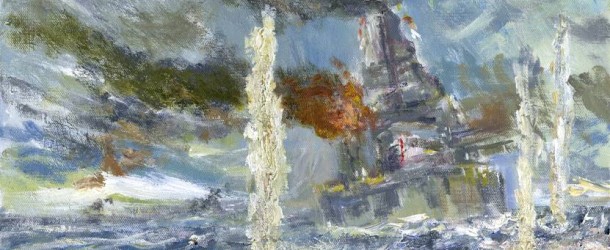
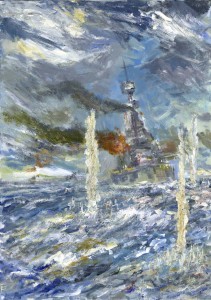

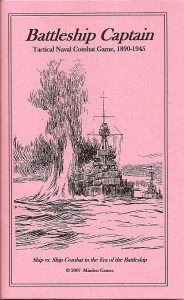
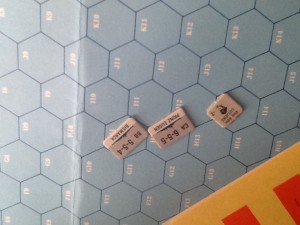
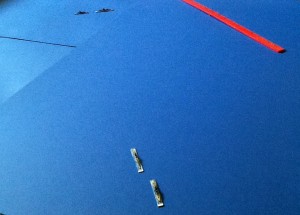
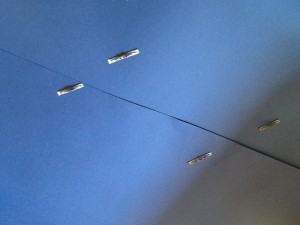
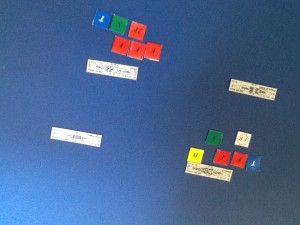






Nice job.
I’ve refought this battle a number of times with different sets of rules and ended up with results similar to yours. Only one time I had the Hood blow up, much as it did in history, otherwise it gets overwhelmed. In truth, until Hood blew up, the British plan was working.